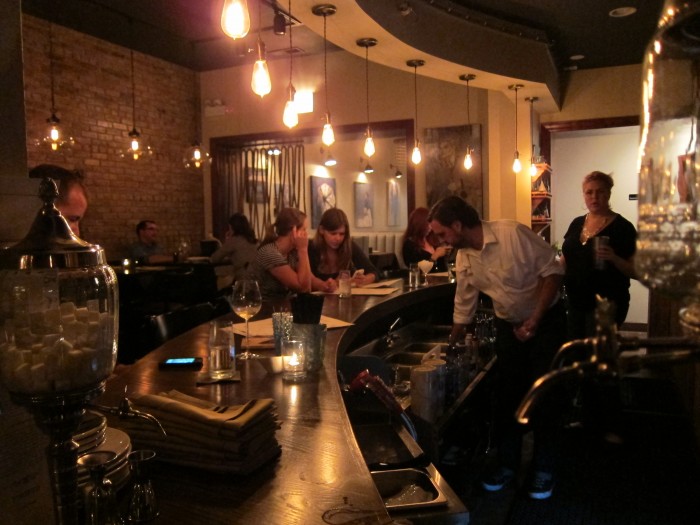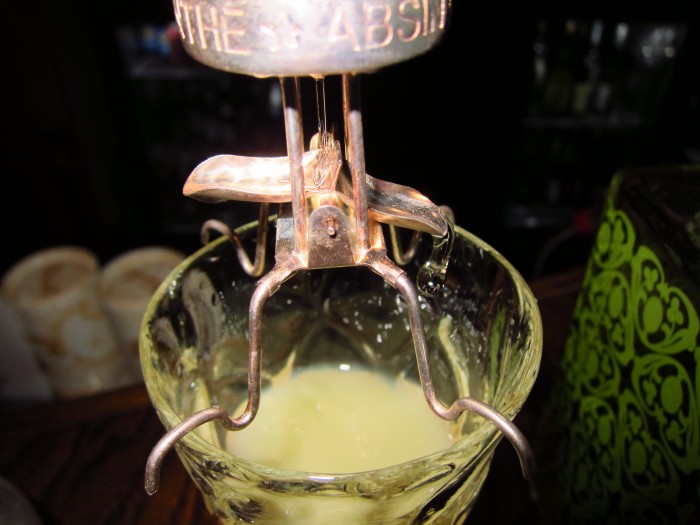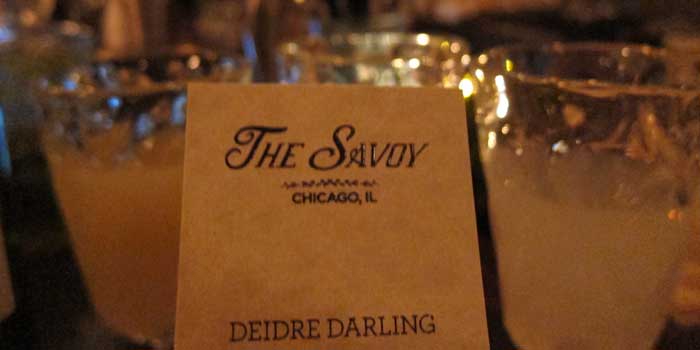It was a Wednesday night when oysters were only $.25 and Deidre Hays, working behind the bar, was lured away by her current boss. “Poached” was the word she used, but it feels more like purloined. At least I like to imagine it was something more akin to the Pied Piper’s charms than innocuous business dealings. But that’s what absinthe does to you; even if you’re not drinking it, writing about it tends to widen the aperture for creative if not dark thought.
“She’s a mixologist, but she doesn’t like to be called that,” informed Emilio, Darling’s right-hand man behind the absinthe bar that is part of Wicker Park’s The Savoy, his luxuriant Spanish accent beautiful filigree to each word. Darling’s’ chagrin, it would turn out, has to do with an art that’s not nearly as heralded and sexy as that of the chemical wizardry denoted by the name—mixologist—and the larger theme of molecular gastronomy.
“I think mixologists aren’t very good bartenders,” explains Darling. “Every bartender is a mixologist, but not every mixologist is a bartender. Customer service is so much more important than making this gorgeous fifteen-ingredient cocktail. I don’t hate the term. We don’t have any other way to distinguish ourselves from a ‘shot and beer’ bartender, so I’ve been saying absintheur.”
Darling speaks while furiously gyrating a shaker full of ice and God knows what, the shape of a knuckled number eight transmogrifying in the air. There’s a purity of form and a seemingly unnecessary violence to her shake I’ve seen before in those like her, those who are exceedingly competent in their craft. They never touch the bowl of the wine glass, only the stem. They never let the draft spigot dip into the froth of the beer because that would be dirty, sloppy, poor show. When someone like this talks about customer service and taking umbrage about a word used to define who they are, I get goose bumps. Frankly, at that point, Darling could have started talking about filing her nails, and I’d hang on every word, scrubbing them for truths deeper than what the words initially portend.
But always, always, always, there is the green fairy. There are the hallucinations. There are no hallucinations. There is the ritual. There was the ban. There’s the lifting of the ban. There’s Ernest Hemingway with his afternoons and Oscar Wilde with his three stages of awareness and Van Gogh with his ear and Ostwald ripening and thujone and just as much mystery as there is science and enough story and myth and lore to perpetuate a religion and scores of parasitic cults living off the power of the original. Bah! Actually, Christianity (and every other major religion) was inflicted with many of these cults when it started to emerge. You can look at the girthy parts of the Nicene Creed or Apostles’ Creed, dimpled with details, to get a handle on just what these faux strains were preaching and what the legitimate and true Christians were trying to clarify. Maybe Darling is much like these early church folk, straining hard against so much misinformation that “customer service” doesn’t mean just a friendly smile and ability to speak in complete sentences and even better skills at listening. Maybe it means “teacher who has a lot of explaining to do.”
Before we could get into any of that, Darling and Emilio loaded an absinthe fountain with ice and water with two different types of absinthes waiting below. I truly felt like, well, a virgin amidst the practiced; I was actually a little nervous and a little excited. I was also skeptical of the addition of water blowing my skirt up. Reviews burgeoning with mention of lesser known herbs like wormwood, angelica, hyssop and melissa with the more familiar anise, coriander, mint, lemon balm, citrus, pine, sage and thyme primed me for something potentially interesting. But these reviews all failed to impress upon me something that still haunts me as I write this, weeks later: the oily, creamy mouthfeel.
“This tastes so creamy!” I exclaimed, and truly so. I was shocked! And I’m still shocked! How could so many articles, so many people fail to mention this enormous quality, this texture, this heft about the tongue and teeth, so at odds with the minty-“stings the nostrils,” herbal, I-just-smudged-the-spirits-away-sage clean aromas and consequent flavors! In a word? Louche.
Pronounced LOO-sh, it’s a word so efficient, it circumvents such descriptions and waxings on because it is its own category. Said in a different way, when reviewing an absinthe, protocol merits description of not only the appearance, bouquet and flavors but the louche as well. And this is how it should be. There should be a category. Unfortunately, this efficiency of a word—louche—takes with it the casualty of wordiness. And in writing, this inefficiency arising in wordiness can be the very thing that makes you melt and get goose bumps. There is another reason for my shock, however.
There are a lot of canards still very much alive and well about absinthe. When I was trying to find out just what is happening causing absinthe to transform from clear to cloudy, from painful (the alcohol content is sometimes up to 148 proof) to a panoply of herbal and floral bouquets and flavors, I had some difficulty. The Wormwood Society Absinthe Association, an enormous resource for well-written reviews as well as fascinating forum discussions from folks who clearly know what they’re talking about and care to boot, explain the louche with a research paper from researchers out of Wageningen University in the Netherlands, published early in 2008. What’s unfortunate is that this is a scientific paper that doesn’t even mention “louche.” Not once. This is a great disservice to folks like me who are desperate to know the nitty gritty behind this incredible transformation but are so new to words like “absinthe” and “Pastis” that they flounder.
Thankfully, someone started a forum discussion on their site entitled: “The Science Behind the Louche: I Still Ain’t Getting It.” There are moments where a lot of these scary terms are broken down or discussed in a conversational or casual way in which one can glean the significance of a word from its context. There are also a few journalists who have enough empathy and competence to break down the Ouzo Effect or Ostwald ripening or even solutions versus microemulsions versus suspensions, etc. David Brown of The Washington Post gives a gracefully pithy description in an article I found in the forum on what is still mysterious about absinthe. And while he wasn’t as impressed with the texture as I, Eric Asimov from The New York Times renders the magic well:
Water not only changes the flavors, it almost magically alters the appearance of the absinthe. As you slowly add water, the liquid in the glass seems to thicken, and transforms into an opalescent pastel cloud. The French call this effect the louche (which has the wonderful double meaning of turbulent in French and disreputable in English). Technically, when absinthe is distilled, the anise and fennel oils dissolve into the alcohol. As the water dilutes the alcohol, it frees the oils from their molecular prison, and they form a cloudy suspension.
Another source comes straight from none other than the American Chemical Society (ACS), the grand poobah of primary source material for anything involving chemistry. Ironically, the video they put together comes off as a little sketchy because along with the essentials about absinthe and the correct pronunciations of some words from the absinthe lexicon, theACS folded in information regarding the use of theACS in researching absinthe or anything else you fancy. Consequently, it feels a little like marketing or instructional.
Many sites go on and on about the thujone (“THOO-jone”) content in absinthe. Many of these same sites were created before thujone was proven to not cause hallucinations, at least not as it comes in absinthe. Alas, when you troll the interwebs for information, these sites are legion. Beyond that, one doesn’t need the internet to be familiar with the connection between hallucinating and absinthe. But try to find out if the water needs to be cold? (it doesn’t) Try to find out if the effect will happen if you just pour some absinthe on the rocks? (it will) Try to find out more about the creamy quality that I’m so enamored with? I get a site purporting that the absinthe buzz is different from all others because of the herbs. Sounds great, but in this month’s issue of The Atlantic, writer Wayne Curtis dispels the myth of different buzzes in his article, “Does Tequila Make Us Crazy?” At the same time, Radiolab put together a show several years ago on the power of the placebo. If you believe you’re going to have a different type of buzz, then maybe you will.
Philosopher Alfred North Whitehead once said that “[i]t is more important that a proposition be interesting than that it be true.” To have someone who is interesting make you feel interesting deliver something interesting to you in a glass is just as holy as the absinthe trinity herbs of anise, fennel and wormwood. Darling knows this during a time when the Third Wave is happening with coffee, when centrifuges are replacing blenders in kitchens, when folks are risking fines and angry neighbors to keep chickens and bees and goats in their backyards for more than just good food. America’s palate is changing in a way that goes beyond what you put in the glass. Politics, ethics, biodynamics and even the type of glass are becoming more and more important to what you are sipping and eating. And say what you will about Dos Equis’ most interesting man; there’s nothing more interesting than a drink that needs a frickin’ fountain to taste good. And with Chicago’s special relationship to wormwood via Malört (a runner-up to a Twitter contest for its slogan, “Malort: Because these pants aren’t gonna shit themselves!”), The Savoy’s absinthe bar with Deidre Darling at the helm is a classier, tastier, most interesting version of something already part of Chicago’s palate.



